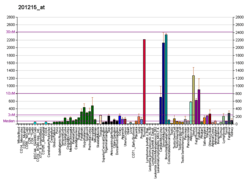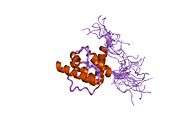PLS3
Plastin-3 is a highly conserved protein that in humans is encoded by the PLS3 gene on the X chromosome.[5][6]
Function
Plastins are a family of actin-binding proteins that are conserved throughout eukaryote evolution and expressed in most tissues of higher eukaryotes. In humans, two ubiquitous plastin isoforms (L and T) have been identified. Plastin 1 (otherwise known as Fimbrin) is a third distinct plastin isoform which is specifically expressed at high levels in the small intestine. The L isoform is expressed only in hemopoietic cell lineages, while the T isoform has been found in all other normal cells of solid tissues that have replicative potential (fibroblasts, endothelial cells, epithelial cells, melanocytes, etc.). The C-terminal 570 amino acids of the T-plastin and L-plastin proteins are 83% identical. It contains a potential calcium-binding site near the N-terminus.[6]
Clinical significance
Defects in PLS3 are associated with osteoporosis and bone fracture in humans and in knockout zebrafish.[7]
References
- 1 2 3 GRCh38: Ensembl release 89: ENSG00000102024 - Ensembl, May 2017
- 1 2 3 GRCm38: Ensembl release 89: ENSMUSG00000016382 - Ensembl, May 2017
- ↑ "Human PubMed Reference:".
- ↑ "Mouse PubMed Reference:".
- ↑ Lin CS, Park T, Chen ZP, Leavitt J (Mar 1993). "Human plastin genes. Comparative gene structure, chromosome location, and differential expression in normal and neoplastic cells". J Biol Chem. 268 (4): 2781–92. PMID 8428952.
- 1 2 "Entrez Gene: PLS3 plastin 3 (T isoform)".
- ↑ van Dijk FS, Zillikens MC, Micha D, Riessland M, Marcelis CL, de Die-Smulders CE, Milbradt J, Franken AA, Harsevoort AJ, Lichtenbelt KD, et al. (October 2013). "PLS3 Mutations in X-Linked Osteoporosis with Fractures". N. Engl. J. Med. 369 (16): 1529–36. PMID 24088043. doi:10.1056/NEJMoa1308223.
Further reading
- Lin CS, Aebersold RH, Leavitt J (1990). "Correction of the N-terminal sequences of the human plastin isoforms by using anchored polymerase chain reaction: identification of a potential calcium-binding domain.". Mol. Cell. Biol. 10 (4): 1818–21. PMC 362293
 . PMID 2378651.
. PMID 2378651. - Lin CS, Aebersold RH, Kent SB, et al. (1988). "Molecular cloning and characterization of plastin, a human leukocyte protein expressed in transformed human fibroblasts.". Mol. Cell. Biol. 8 (11): 4659–68. PMC 365555
 . PMID 3211125.
. PMID 3211125. - Goldstein D, Djeu J, Latter G, et al. (1985). "Abundant synthesis of the transformation-induced protein of neoplastic human fibroblasts, plastin, in normal lymphocytes.". Cancer Res. 45 (11 Pt 2): 5643–7. PMID 4053036.
- Arpin M, Friederich E, Algrain M, et al. (1995). "Functional differences between L- and T-plastin isoforms.". J. Cell Biol. 127 (6 Pt 2): 1995–2008. PMC 2120298
 . PMID 7806577. doi:10.1083/jcb.127.6.1995.
. PMID 7806577. doi:10.1083/jcb.127.6.1995. - Maruyama K, Sugano S (1994). "Oligo-capping: a simple method to replace the cap structure of eukaryotic mRNAs with oligoribonucleotides.". Gene. 138 (1-2): 171–4. PMID 8125298. doi:10.1016/0378-1119(94)90802-8.
- Lin CS, Shen W, Chen ZP, et al. (1994). "Identification of I-plastin, a human fimbrin isoform expressed in intestine and kidney.". Mol. Cell. Biol. 14 (4): 2457–67. PMC 358613
 . PMID 8139549. doi:10.1128/mcb.14.4.2457.
. PMID 8139549. doi:10.1128/mcb.14.4.2457. - Goldsmith SC, Pokala N, Shen W, et al. (1997). "The structure of an actin-crosslinking domain from human fimbrin.". Nat. Struct. Biol. 4 (9): 708–12. PMID 9302997. doi:10.1038/nsb0997-708.
- Shoeman RL, Hartig R, Hauses C, Traub P (2003). "Organization of focal adhesion plaques is disrupted by action of the HIV-1 protease.". Cell Biol. Int. 26 (6): 529–39. PMID 12119179. doi:10.1006/cbir.2002.0895.
- Rao RM, Rama S, Rao AJ (2004). "Changes in T-plastin expression with human trophoblast differentiation.". Reprod. Biomed. Online. 7 (2): 235–42. PMID 14567899. doi:10.1016/S1472-6483(10)61758-0.
- Su MW, Dorocicz I, Dragowska WH, et al. (2004). "Aberrant expression of T-plastin in Sezary cells.". Cancer Res. 63 (21): 7122–7. PMID 14612505.
- Giganti A, Plastino J, Janji B, et al. (2005). "Actin-filament cross-linking protein T-plastin increases Arp2/3-mediated actin-based movement.". J. Cell. Sci. 118 (Pt 6): 1255–65. PMID 15741236. doi:10.1242/jcs.01698.
- Ralser M, Nonhoff U, Albrecht M, et al. (2005). "Ataxin-2 and huntingtin interact with endophilin-A complexes to function in plastin-associated pathways.". Hum. Mol. Genet. 14 (19): 2893–909. PMID 16115810. doi:10.1093/hmg/ddi321.
- Ikeda H, Sasaki Y, Kobayashi T, et al. (2006). "The role of T-fimbrin in the response to DNA damage: silencing of T-fimbrin by small interfering RNA sensitizes human liver cancer cells to DNA-damaging agents.". Int. J. Oncol. 27 (4): 933–40. PMID 16142308. doi:10.3892/ijo.27.4.933.







